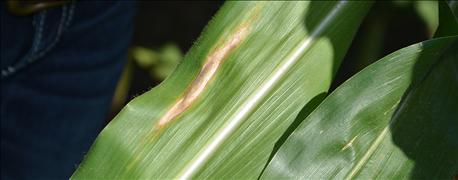
Your ag supplier may already be asking you about which cornfields you want to spray with fungicide this summer. From his side of the fence, he has product to order and custom applicators to line up to hit what is always a very narrow window for fungicide application. Agronomists recommend staying on your side of the fence, and making decisions about fungicide use and timing of potential applications that make economic sense for you.

MAKE FUNGICIDE DECISIONS: You don’t have the luxury of knowing how much disease may be present later if you attempt to make fungicide decisions now.
A panel of three Indiana Certified Crop Advisers points to three keys for making decisions about fungicide applications. They are Jamie Bultemeier, Great Lakes A&L Labs, Fort Wayne; Gene Flaningam, Flaningam Ag Consulting LLC, Vincennes; and Bryan Overstreet, Purdue University Extension ag educator in Jasper County.
1. Assess the need to spray fungicide in the first place.
“I would scout the field before making an application to see if the disease you are spraying for is even present,” Overstreet says. “And if it is present, are disease levels severe enough to warrant a fungicide application?”
Overstreet refers farmers he advises to a publication prepared by Purdue Extension. It’s called Fungicide Efficacy for Control of Corn Diseases. Find it at extension.purdue.edu/extmedia/BP/BP-160-W.pdf.

DETERMINE DISEASE LEVEL: Here is the tricky part of making fungicide decisions. If this is the only lesion you've found and pollination is approaching, check more closely with your seed rep and weatherman.
2. Hit a narrow window for best results.
Research shows the most consistent and beneficial time to apply foliar fungicides in corn is from VT, or tasseling, to R2, after silks turn brown, Bultemeier says. In 2015, Kiersten Wise, Purdue Extension plant pathologist, announced field results indicating that to achieve the most benefit, fungicides should be applied before silks turn brown.
“The thought behind waiting to apply the fungicide has been to protect the plant longer into the grain-fill period,” Bultemeier explains. However, he notes that this philosophy has a few challenges.
“The VT-to-R2 window can be rather narrow; waiting on brown silks can dramatically decrease your window of application,” he says. “Yield benefits really decrease if application is made after R2.”

MISSED THE WINDOW: Once brown silks dominate the field, most agronomists agree you’ve missed the window to gain maximum benefits from a fungicide application.
3. Refer to the product's label before making a final decision on application timing.
If scouting the field to see if you even need a fungicide is the first key, and aiming for a narrow window is second, then the third key is surely checking product labels carefully, Flaningam says. “The primary application timing of each fungicide will be determined by the product label,” he says.
One reason for checking labels is to find out if there are restrictions on the back end of the season, he notes. Some products have harvest restrictions after application. The range is wide, running from seven to 36 days, Flaningam notes. You can only find that information by checking fungicide labels.
Timing could depend on severity of the disease, Flaningam says. He suggests scouting regularly, and talking to your seed sales rep in advance to get a better handle on the resistance or susceptibility of each hybrid to various diseases.
“Weather predictions during grain fill could also be a factor,” he says. “Wet, cloudy weather speeds up disease development.”

WEATHER CONDITIONS MATTER: Depending upon the disease, high humidity, lots of early morning dews like this one and cloudy conditions may favor foliar diseases.
About the Author(s)
You May Also Like




